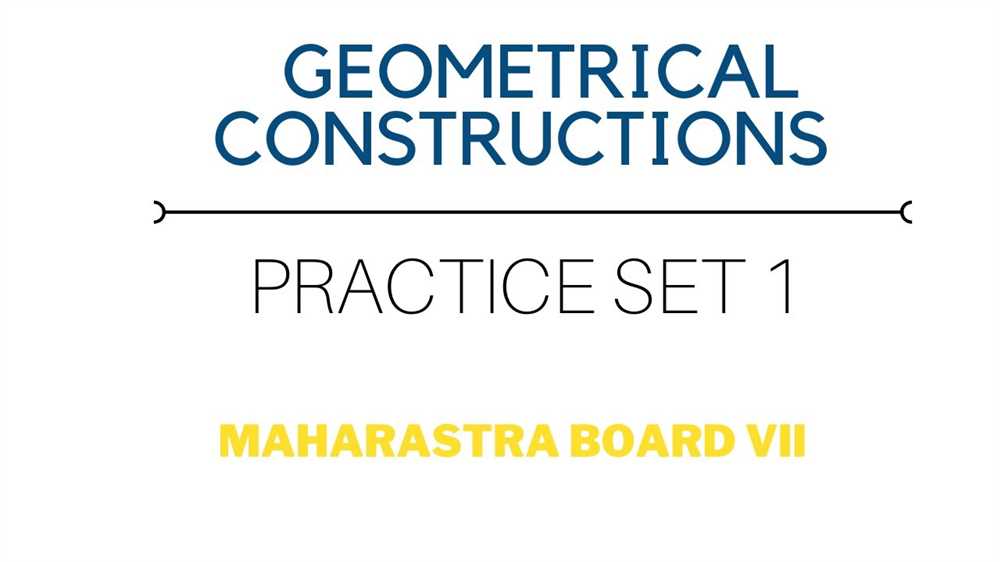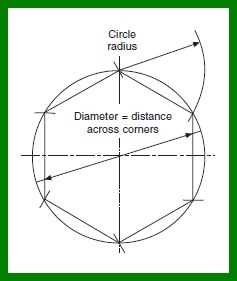
Geometrical construction is an essential skill in mathematics and engineering. It involves using tools and techniques to draw precise figures and shapes. Whether you’re a student studying geometry or a professional working in a technical field, having a solid understanding of geometrical construction is vital.
In this article, we will explore some common questions and answers related to geometrical construction. We will cover topics such as basic constructions, constructions involving angles and triangles, and more advanced constructions involving circles and polygons. Whether you’re looking to refresh your knowledge or learn something new, we’ve got you covered.
One of the fundamental questions in geometrical construction is how to construct basic shapes such as perpendicular lines, parallel lines, and bisectors. We will provide step-by-step instructions on how to construct these shapes using a compass and ruler. Understanding these basic constructions will serve as a foundation for more complex constructions.
Additionally, we will delve into the topic of angle constructions. Angles play a crucial role in geometry, and being able to construct specific angles is a valuable skill. We will discuss how to construct angles of specific measurements, how to bisect angles, and how to construct angle bisectors. These constructions will enable you to accurately measure and reproduce angles in your geometrical drawings.
What is geometrical construction?

Geometrical construction is a methodical process of creating precise shapes, lines, angles, and curves using only a straight edge (such as a ruler) and a compass. It is a fundamental aspect of geometry that allows mathematicians and engineers to accurately visualize and analyze geometric figures.
Geometrical construction involves the use of basic geometric tools to draw and construct various shapes, such as triangles, quadrilaterals, circles, and polygons. Through construction, mathematical properties and relationships between different elements of these shapes can be explored and understood.
Key concepts in geometrical construction:
- Straightedge: A ruler or any other straight and rigid tool used to draw straight lines.
- Compass: A tool with two arms, one fixed and one adjustable, used to draw circles and arcs.
- Point: A location in space, often represented by a dot, used as a starting or ending point for construction.
- Line: A series of points that extends infinitely in both directions. It can be constructed by connecting two points.
- Angle: The space between two intersecting lines or surfaces, measured in degrees. It can be constructed by using two intersecting lines.
- Triangle: A polygon with three sides and three angles. It can be constructed by connecting three non-collinear points.
Geometrical construction is not limited to paper and pencil; it can also be done using computer software and other digital tools. It is a powerful tool in mathematics and engineering, enabling precise and accurate representation of geometric ideas and concepts.
Why is geometrical construction important?
Geometrical construction is an essential skill for engineers, architects, and designers. It allows them to accurately represent and communicate their ideas and designs. Through the use of precise measurements and calculations, geometrical construction helps ensure the structural integrity and aesthetic appeal of buildings, bridges, and other structures.
Accuracy and Precision: Geometrical construction requires meticulous attention to detail and precision. It helps ensure that all angles, lengths, and proportions are accurately represented in a design. This level of accuracy is crucial for creating structures that are stable, functional, and visually pleasing.
Visualization and Communication: Geometrical construction provides a visual representation of an idea or design. It allows designers to communicate their concepts to clients, colleagues, and construction teams. By using geometrical constructions, complex ideas and designs can be easily understood and interpreted by different stakeholders, minimizing misunderstandings and facilitating effective collaboration.
Problem-solving and Innovations: Geometrical construction often involves solving complex mathematical problems. It requires logical thinking, spatial reasoning, and creative problem-solving skills. Through geometrical construction, engineers and designers can find innovative solutions to challenges they encounter during the design and construction process.
Historical Significance: Geometrical construction has played a vital role in the development of various civilizations throughout history. Ancient cultures such as the Egyptians, Greeks, and Romans used geometrical construction principles to create impressive architectural wonders that are still admired today. Understanding and appreciating the historical significance of geometrical construction allows us to learn from the past and apply these principles in modern design and construction.
Foundation for Further Learning: Geometrical construction serves as a fundamental building block for further studies in mathematics, engineering, and architecture. It helps develop important skills such as spatial visualization, logical reasoning, and problem-solving abilities. Additionally, it lays the groundwork for more advanced topics, such as trigonometry and calculus, which are essential in higher-level engineering and architectural disciplines.
In conclusion, geometrical construction is an important skillset that has practical applications in various industries. It fosters accuracy, visualization, problem-solving, and historical awareness. Moreover, it serves as a foundation for further learning and specialization in mathematics, engineering, and architecture.
Basic geometrical constructions
The study of geometry involves the construction of various figures using basic tools and techniques. These constructions allow us to create specific shapes and solve geometric problems. In this article, we will explore some of the basic geometrical constructions and their applications.
Straightedge: One of the most fundamental tools in geometry construction is the straightedge. A straightedge is a ruler without any markings or measurements. It is used to draw straight lines between two points or extend an existing line.
Compass: Another essential tool for geometrical constructions is a compass. A compass is used to draw circles, arcs, and angles of a specific measurement. It consists of two arms: one fixed in place and the other equipped with a pencil or a sharp point.
With these basic tools, several geometrical constructions can be created. Some common examples include:
- Constructing a perpendicular bisector: Given a line segment, the perpendicular bisector can be constructed by drawing arcs from each endpoint of the segment. The point where the arcs intersect is the midpoint of the segment, and drawing a line through this point that is perpendicular to the segment creates the perpendicular bisector.
- Constructing an equilateral triangle: Start by drawing a line segment, then use the compass to create two congruent arcs from each endpoint of the segment. The point where the arcs intersect is the third vertex of the equilateral triangle. Connect the three vertices to form the triangle.
- Constructing an angle bisector: Given an angle, the angle bisector can be constructed by using the compass to draw arcs from each side of the angle. The point where the arcs intersect determines the location of the angle bisector.
These are just a few examples of the many basic geometrical constructions that can be performed. These constructions form the foundation for more complex geometric constructions and problem-solving in the field of geometry.
Straightedge and compass constructions

Straightedge and compass constructions are a fundamental part of geometrical construction. These constructions involve using only a straightedge (a ruler without markings) and a compass to create various shapes or perform specific actions. This restricted set of tools creates a challenge to construct specific geometric figures.
In straightedge and compass constructions, a straightedge is used to draw straight lines, while a compass is used to draw circles with a fixed radius. The constructions typically involve a finite number of steps to achieve a desired result, such as constructing perpendicular or parallel lines, bisecting angles, or finding the midpoint of a line segment.
To perform these constructions, specific techniques and principles are employed. For example, the basic principle of constructing a line perpendicular to another line involves drawing circles with the compass centered on two points of the line and finding the intersection points. By connecting these intersection points with a straightedge, a perpendicular line can be constructed.
Straightedge and compass constructions have been used since ancient times and are still valuable in mathematics and engineering. They offer a unique way to understand geometric principles and properties by physically constructing them. These constructions also serve as a foundation for more advanced mathematical concepts, such as Euclidean geometry.
In conclusion, straightedge and compass constructions are an essential part of geometrical construction, relying on a limited set of tools to create various shapes and perform specific actions. Through the use of specific techniques and principles, these constructions allow for the exploration and understanding of geometric properties and principles. They have a rich history and continue to be an important aspect of mathematics and engineering.
Constructing a perpendicular line
A perpendicular line is a line that intersects another line at a right angle, forming a 90-degree angle. Constructing a perpendicular line involves using geometric tools and principles to ensure that the resulting line is perpendicular to the given line.
One way to construct a perpendicular line is by using a compass and a straightedge. Given a line segment AB, start by placing the compass at point A and drawing an arc that intersects the line twice. Without changing the compass width, place the compass at point B and draw another arc that intersects the line segment twice. The two intersection points should form an arc, and connecting these points with a straightedge will result in a perpendicular line to AB at point B.
Example:
- Given line segment AB
- Place the compass at point A and draw an arc that intersects the line twice
- Keep the compass width the same and place it at point B, drawing another arc that intersects the line twice
- Connect the two intersection points to form a perpendicular line at point B
Another method to construct a perpendicular line is by using the concept of the midpoint. Given a line segment AB, locate its midpoint M. From point M, draw a line that intersects AB at a right angle. This line will be perpendicular to AB.
Example:
- Given line segment AB
- Locate the midpoint M of AB
- Draw a line from M that intersects AB at a right angle
- This line will be a perpendicular line to AB
Constructing a perpendicular line is a fundamental concept in geometry and is used in various applications, such as constructing perpendicular bisectors, finding the distance between a point and a line, and solving problems involving right angles.
Constructing an Angle Bisector

An angle bisector is a line or ray that divides an angle into two equal parts. Constructing an angle bisector is a common task in geometry, and it can be done using a compass and straightedge. It is an important concept because angle bisectors are used in many geometric proofs and constructions.
To construct an angle bisector, follow these steps:
- Step 1: Draw the given angle. Use a straightedge to draw a line segment, forming an angle with two rays extending from its endpoints.
- Step 2: Place the compass at the vertex of the angle. Adjust the compass width to a convenient radius, and draw arcs intersecting both rays of the angle.
- Step 3: Without changing the compass width, place the compass point on one of the intersection points of the arcs. Draw an arc that intersects the original angle.
- Step 4: Repeat Step 3 using the other intersection point as the compass point. The two arcs should intersect at a single point.
- Step 5: Use a straightedge to draw a line segment connecting the vertex of the angle to the point where the arcs intersect. This line segment is the angle bisector.
By constructing an angle bisector, you can divide an angle into two equal parts. This tool is helpful when solving geometric problems involving angles, such as finding the measures of unknown angles or proving congruence between angles.
Advanced geometrical constructions
In the field of geometry, there are various advanced constructions that go beyond basic constructions like bisecting angles or constructing perpendicular lines. These advanced geometrical constructions involve more complex techniques and can be used to solve more intricate geometric problems.
One example of an advanced geometrical construction is the construction of an equilateral triangle within a given triangle. This construction is often used to find the centroid of a triangle. To construct the equilateral triangle, one can start by drawing a line segment from the midpoint of one side of the triangle to the opposite vertex. Then, using this segment as the radius, one can draw arcs on the other two sides of the triangle. The intersection points of these arcs will form the vertices of the equilateral triangle.
Another advanced geometrical construction is the construction of the incenter of a triangle. The incenter is the point of intersection of the angle bisectors of a triangle. To construct the incenter, one can first construct the angle bisectors of two of the angles in the triangle. The point of intersection of these bisectors will be the incenter. This construction is useful in various geometric problems, such as finding the center of the inscribed circle in a triangle.
One more advanced geometrical construction is the construction of the circumcenter of a triangle. The circumcenter is the point of intersection of the perpendicular bisectors of the sides of a triangle. To construct the circumcenter, one can first construct the perpendicular bisectors of two of the sides of the triangle. The point of intersection of these bisectors will be the circumcenter. This construction is utilized in problems involving the circumscribed circle of a triangle, such as finding the radius of the circle.
Overall, advanced geometrical constructions open up new possibilities for solving complex geometric problems. Mastering these constructions can enhance one’s understanding of geometry and enable the solving of more challenging problems.